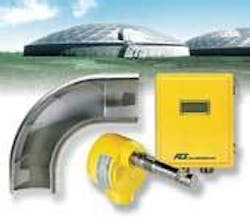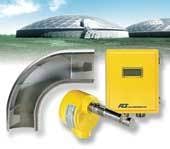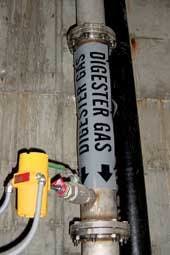New Flow Meter Optimizes Digester Biogas Measurement
by Steven Craig
The engineers at a municipal wastewater treatment utility were expanding their biogas digester system and were seeking an improvement over their existing, maintenance-intensive flow metering technology. They needed to measure the amount of gas contained within a gas bag as well as the flow rate of the gases traveling from the gas bag system into a co-generation power system.
Digester gas is a mixed composition, consisting of methane, CO2 and trace gases. The amount of biogas flowing is a critical process parameter in order to prevent an excessive build-up of gas in the digester, to minimize excess waste gas flaring into the environment, to ensure operation of the co-generation engine system and to prevent the release of the potentially hazardous gas that might threaten plant personnel or send high levels of obnoxious odors into areas outside the plant.
Such digester gas bag systems are designed as a dome-shaped, engineered membrane station to hold methane biogas, provide for sludge storage and prevent odors. There are multiple types and manufacturers of gas bags. A typical bag system includes two durable membranes. The outer membrane is cable restrained and remains inflated in a fixed position. The inner membrane moves freely as it stores or releases gas generated from an anaerobic digestion process.
The utility measures the gas flow in and out of the digester gas bag system with flow meters connected to a primary programmable logic controller (PLC). The flow meter and PLC provide a real-time, running calculation of the gas quantity in the gas bag system. The PLC then communicates with and sends commands to a distributed control system (DCS) to take actions based upon the quantity of gas.
In the event of excessive biogas (methane) build-up, a system alarm notifies the operations staff and the primary PLC issues a command to the DCS telling it to take action by using the extra gas in one of several ways:
- Increase the load for an online co-gen power engine.
- Start a secondary co-gen power engine.
- Increase the load of both online co-gen power engines
- Send it to a flaring stack and ignite the flare to burn off the excess gas
The digester and co-generation system’s operation and control are highly dependent on the accurate and repeatable biogas flow measurement. The existing flow meters had often clogged and stopped functioning in the system’s dirty biogas environment. This situation could have led to the build-up of excess gas, which can result in unsafe operating and undesirable environmental conditions. The co-gen power engines were also less energy efficient when the gas mixture was improperly measured, and the maintenance required on the meters was a time-consuming, extra expense.
The flow meters for the gas bag system needed to operate over a wide flow range from 1.64 to 1640 SFPS and at pressures from 0.8 to 17.6 psig. The replacement flow sensing technology needed to be robust and low maintenance enough to operate in a biogas environment where the gas can be wet and may contain particulates.
To solve the problem, the utility contacted Fluid Components International (FCI) and requested assistance. The company recommended an FCI Model GF90 Series thermal mass flow meter and a Vortab® meter run (VMR) flow conditioner. Thermal mass flow instruments are available from several manufacturers, and they have been applied within wastewater treatment applications for decades.
The thermal mass flow meter features a no-moving parts design, which is well suited to the dirty gases found in both wastewater and organic waste treatment processes. The GF90 flow meter was selected because it features a smart transmitter with three separate calibration group settings and relay outputs for alarm tripping purposes. With three user-selectable flow meter gas calibration groups, the utility’s engineers were able to achieve the widest possible flow range and system accuracy by selecting the calibration matched to the current process operating conditions.
Multiple gas calibration groups within the flow meter’s transmitter are useful in biogas applications where the mix of methane, carbon dioxide and other trace gases can shift with variable waste material content, processes or weather. In applications where the gas mixture is more stable, a flow meter with single-gas calibration is an effective, lower-cost solution.
In addition to the digester gas bag, the system also includes an array of piping and processes for gas distribution and disposition. Thermal mass flow meters calibrated for digester gases are also well suited for these applications. Flare gas stacks typically require a flow meter to measure and report the quantity of gases burned off and as feedback for the digester’s process control. In the co-generation system, gas flow meters are installed at the engine’s fuel feed lines, both in digester gas lines and supplemental natural gas lines that ensure engine operation and BTU performance.
In planning the installation of the digester system’s new flow meters, the piping layout was found to be less than optimal for accurate measurement. Nearly all flow meter technologies require a straight pipe run of 0-10 diameters upstream and 0-5 diameters downstream, or more. In this case, there were problematic elbows too close to the meter. The team saved re-piping costs by installing a tab-type Vortab meter run flow conditioner. The conditioner eliminated any undesirable line conditions, such as swirl, and ensured a fully developed flow profile for accurate measurement in only nine diameters total.
Results
The digester gas system now operates more effectively and efficiently. The utility is able to achieve improved digester process control, ensure compliance with local environmental regulations and optimize the operation of its co-gen engine system. Their maintenance expenses also were dramatically reduced, with the thermal mass flow meter requiring virtually no attention because of its no-moving parts, non-fouling design.
About the Author:
Steven Craig is a Senior Member of the Technical Staff at Fluid Components International (FCI). He has a Bachelor of Science degree from Iowa State University and 20 years of instrumentation experience, 10 years in aerospace and 10 years with FCI. He works in the FCI Beijing, China, office.



